While most people think of geese as being residents of cold climates, you might be surprised to know that there are flocks of geese living in California.
In fact, these feathered friends can be found in many parts of the state, from the Sacramento Valley to the Pacific Flyway.
So if you’re a California bird watcher, don’t forget to add geese to your list of species to watch for!
What Kind of Geese Are in California?
There are 6 goose species and 3 swan species in California:
| Goose | Frequency in California | Resident Population | Specific Locations in California |
|---|---|---|---|
| Canada Goose | Common | Yes | Tule Lake National Wildlife Refuge, San Francisco Bay Area |
| Snow Goose | Uncommon | No | Sacramento National Wildlife Refuge Complex, Salton Sea |
| Ross’s Goose | Uncommon | No | Sacramento National Wildlife Refuge Complex, Central Valley |
| Cackling Goose | Common | No | San Joaquin River National Wildlife Refuge, Sacramento-San Joaquin Delta |
| Greater White-fronted Goose | Uncommon | No | Sacramento National Wildlife Refuge Complex, Central Valley |
| Brant | Uncommon | No | Morro Bay, Humboldt Bay |
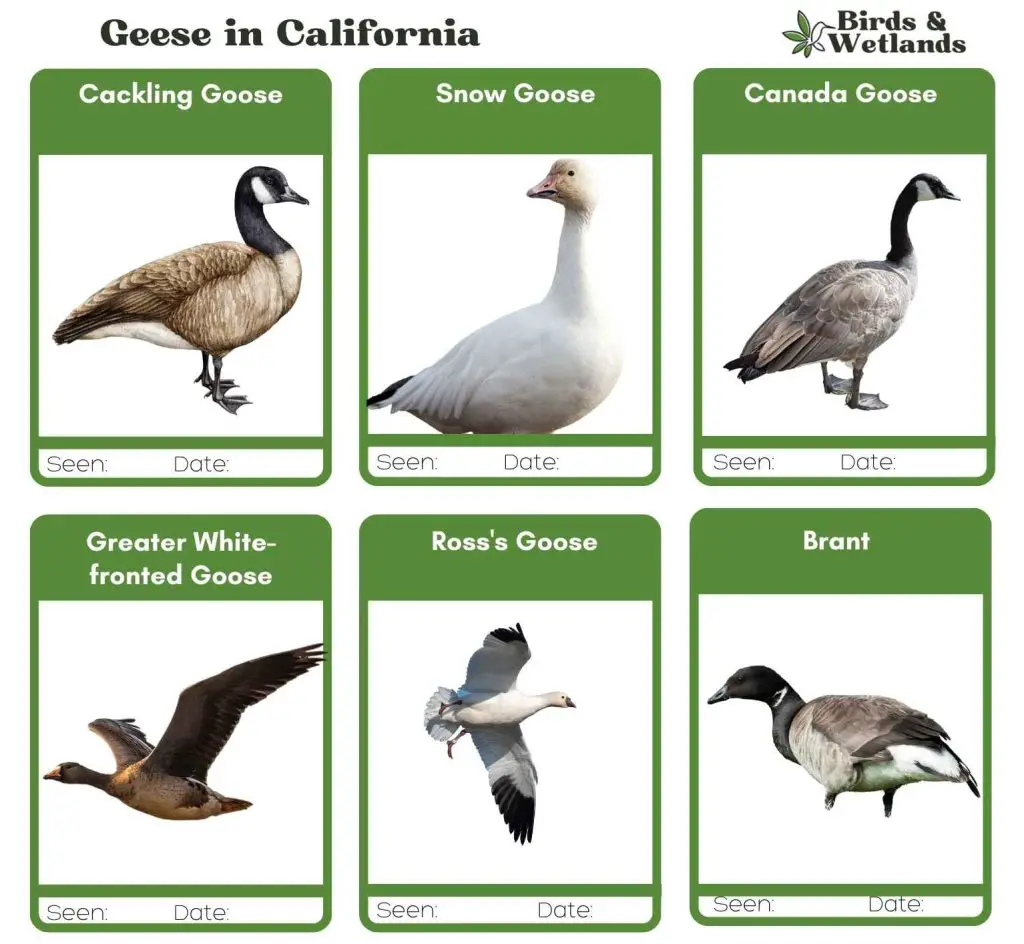
Geese Species Found in California
Canada Goose


Canada Goose Sound
Scientific Name: Branta canadensis
Length: 30 to 43 in
Wingspan: 50–73 in
Weight: 5.7–14.3 lb
The Canada Goose is a large, well-known species of waterfowl noted for its distinctive appearance, familiar “honk,” and migratory behavior.
Appearance: Both male and female Canada Geese have a similar appearance, featuring a black head and neck with distinctive white patches on the cheeks and chin. The body is primarily brown with a lighter, often white, underbelly.
Diet: Canada Geese primarily feed on plant matter, including grasses, aquatic vegetation, and grains. They can often be seen grazing in parks, lawns, and fields, as well as dabbling in water bodies.
Reproduction: Canada Geese typically nest on the ground near water bodies, often on islands or other isolated areas to avoid predators. The female lays a clutch of about 4 to 6 eggs, which she incubates alone for around a month.
Snow Goose

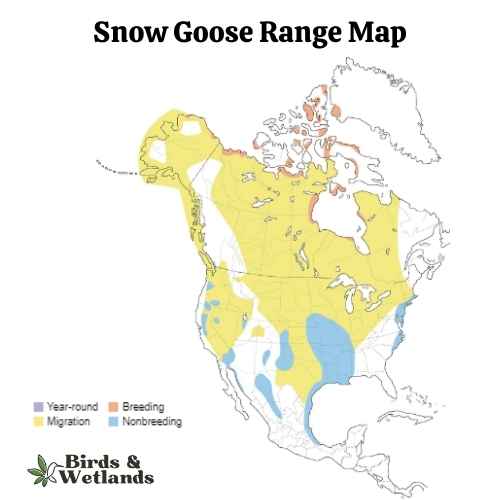
Snow Goose Sound
Scientific Name: Anser caerulescens
Length: 25 to 31 in
Wingspan: 53 to 65 in
Weight: 4.5 to 6.0
The Snow Goose is a large species of waterfowl known for its vibrant white plumage and significant migratory flights.
Appearance: True to their name, Snow Geese are predominantly white with black wingtips. They also have a pink bill, pink legs and feet. A color morph, known as the “Blue Goose,” displays a bluish-gray body with a white head, but is considered the same species.
Diet: Snow Geese primarily feed on plant matter, such as grasses, sedges, and small grains. They can often be seen in large flocks foraging in fields and marshes, and during migration and winter, they can cause considerable damage to agricultural fields due to their feeding habits.
Reproduction: Snow Geese typically nest on the tundra, near water bodies. The female builds the nest and lays a clutch of about 3 to 5 eggs, which she incubates alone for approximately three weeks. Once hatched, the goslings can feed themselves but stay with their parents for protection until they can fly.
Snow geese are a magnificent sight to behold in California. These beautiful birds, known for their striking white plumage, migrate from as far as Russia but predominantly geese from Alaska and western Canada. During their summer breeding grounds, snow geese go through a molting phase, losing their flight feathers and temporarily grounding them.
It is a crucial period for these geese, allowing them to rest and rebuild their strength. As summer comes to an end, their flight feathers regrow, and the snow geese embark on their awe-inspiring journey to the western United States and Mexico.
Ross’s Goose
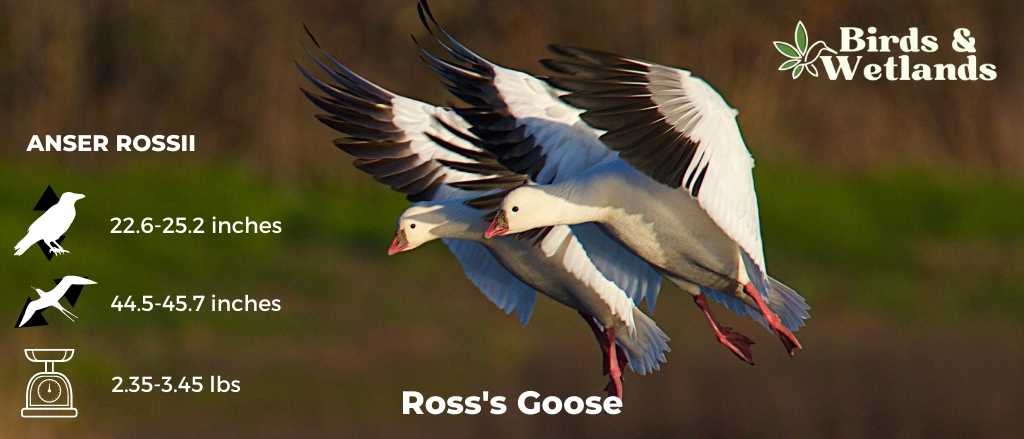
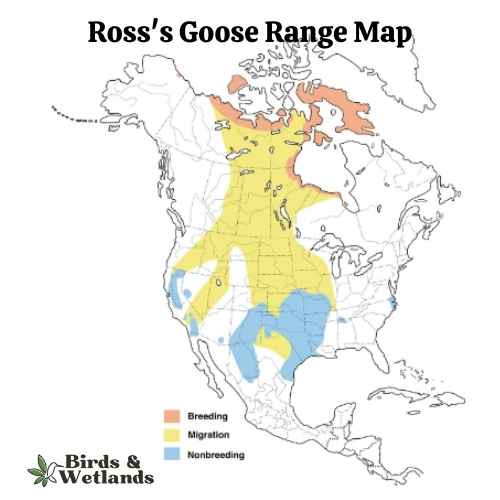
Listen
Scientific Name: Anser rossii
Length: 23.2-25.2
Wingspan: 44.5-45.7 in
Weight:42.3-55.3 oz
The Ross’s Goose is a small species of waterfowl often found in North America’s tundra and wetland habitats.
Appearance: Known for its compact size, the Ross’s Goose is mostly white with black wingtips. It features a short, stubby bill and a rounded head. One key identifying feature is the blueish gray base of its bill, which has a warty structure during the breeding season.
Diet: This goose feeds mainly on vegetation, including seeds, leaves, and roots of grasses and sedges. During winter and migration, they also consume grains and seeds from agricultural fields.
Reproduction: The Ross’s Goose nests on the ground, often in colonies. The female lays a clutch of 2 to 5 eggs which she incubates for around three weeks. The young geese, known as goslings, are precocial – they can walk, swim, and feed themselves shortly after hatching, although they stay with their parents until they learn to fly.
Ross’s geese, a smaller relative of the snow geese, can be found in California during their migration periods. These delightful white geese with black wingtips make appearances in various wetlands and protected areas across the state, adding their unique charm to California’s diverse avian population.
Cackling Goose
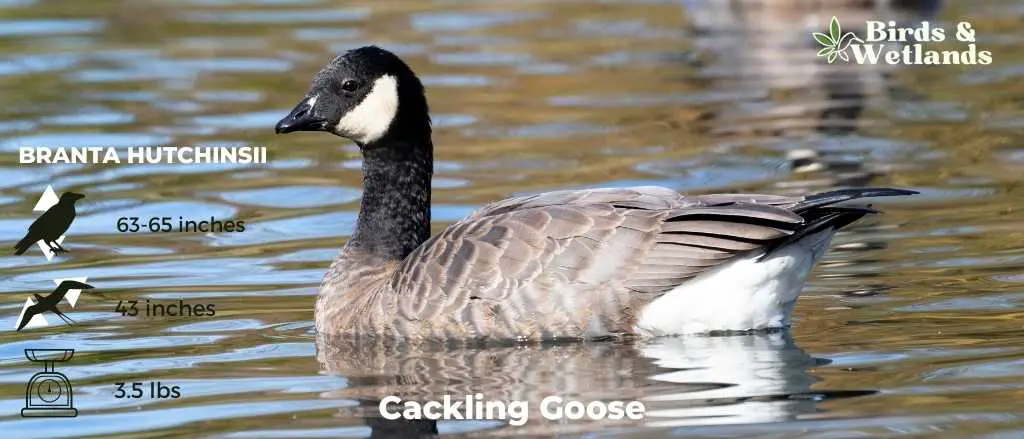
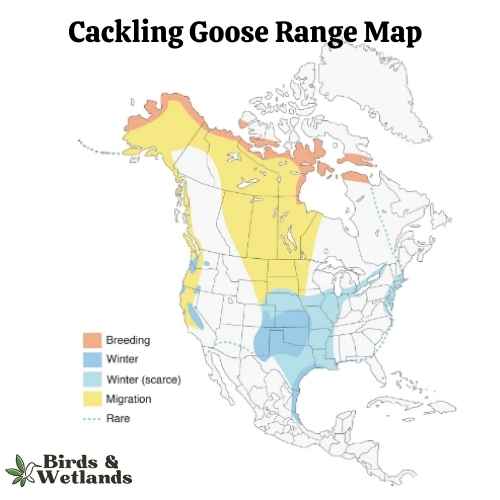
Listen
Scientific Name: Branta hutchinsii
Length: 24.8–25.6 in
Wingspan: 43-45.7 in
Weight:3.5 lbs
Cackling Geese are particularly known for their high-pitched, cackling calls, which is the source of their name. Despite their small size, these geese are renowned long-distance migrants, with some populations traveling thousands of miles between breeding and wintering grounds.
Appearance: With a similar color pattern to the larger Canada Goose, the Cackling Goose features a black head and neck, white chinstrap, light tan to cream chest, and brownish-grey body. One defining characteristic is its noticeably smaller size and stubbier neck compared to its larger counterparts.
Diet: Like many geese, the Cackling Goose’s diet mainly consists of plant matter. This includes grasses, seeds, and aquatic vegetation. They are often seen grazing on land or dabbling in shallow water.
Reproduction: Cackling Geese usually nest on the ground in elevated areas near water bodies, such as riverbanks or lakeshores. The female lays a clutch of 2 to 8 eggs and is responsible for incubation, while the male stands guard nearby. Incubation lasts for about a month.
Cackling geese can be found in various locations throughout California during their migration periods. Some key areas where you may spot Cackling geese include the Sacramento-San Joaquin Delta, the San Joaquin River National Wildlife Refuge, and wetlands along the Pacific Flyway.
These geese often gather in agricultural fields, marshes, and coastal areas, providing excellent opportunities for birdwatchers and nature enthusiasts to observe and appreciate their presence in the Golden State.
Greater White-fronted Goose
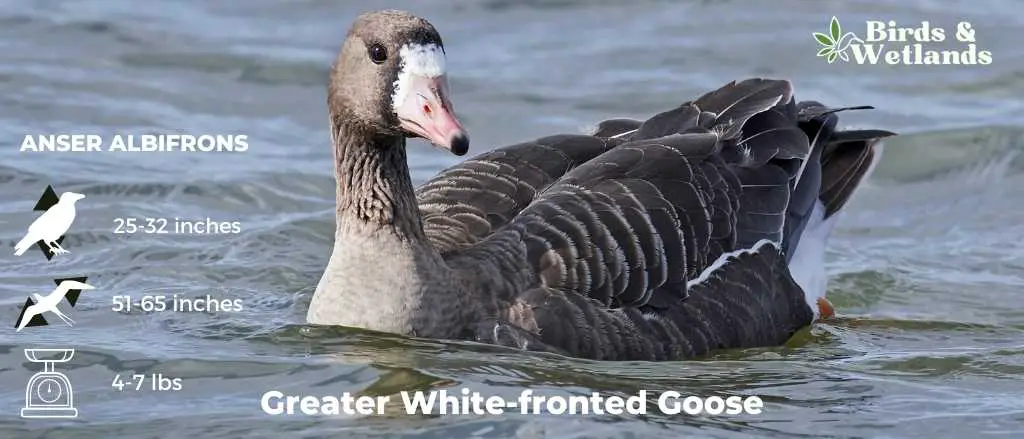

Listen
Scientific Name: Anser albifrons
Length: 25 to 31 in
Wingspan: 53 to 66 in
Weight: 3.3 to 6.6
The Greater White-fronted Goose is a medium to large waterfowl species, widely distributed across the Northern Hemisphere, particularly in North America.
Appearance: As the name suggests, these geese display a prominent white patch at the base of their bill. Their bodies are gray-brown, and their breasts are often marked with dark blotches. They possess a pinkish bill and orange legs and feet.
Diet: The Greater White-fronted Goose is a herbivore and feeds mainly on plant material. Its diet consists of grasses, sedges, grains, and berries. When wintering, these geese can often be found in agricultural fields, feasting on leftover grains and crops.
Reproduction: This species nests on the ground, often in areas with good visibility such as slopes or ridges. The female lays a clutch of 4 to 5 eggs, which she incubates for nearly a month. Once hatched, the young ones are taken care of by both parents until they are able to fly.
Brant

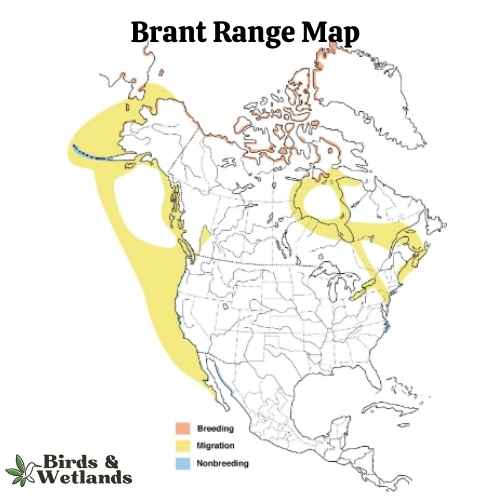
Listen
Scientific Name: Branta bernicla
Length: 22–26 in
Wingspan: 42–48 in
Weight: 1.9–4.9 lb
The Brant is a compact species of goose that is known for its striking appearance and interesting migratory patterns.
Appearance: The Brant is recognized for its dark, sooty color with a white crescent on the neck. The body is mostly black to dark gray, contrasting with the lighter underparts. Its small size, as compared to other geese, and short, stubby bill are other distinct features.
Diet: The Brant’s diet primarily consists of aquatic plants, especially eelgrass and sea lettuce. During the breeding season, they may also feed on grasses, sedges, and insects.
Reproduction: Brants typically breed in the high Arctic tundra. The female lays a clutch of 3 to 5 eggs in a ground nest, which she incubates for about a month.
Notably, Brants make an impressive long-distance migration every year. They spend their winters along both the east and west coasts of the United States and travel to the Arctic regions of Canada, Alaska, and even Russia to breed.
Where to Spot California’s Geese
Sacramento National Wildlife Refuge Complex: Located in the heart of the Sacramento Valley, this complex of wildlife refuges offers exceptional opportunities for observing a wide range of geese species as it makes the perfect bird habitat, not just for the geese but also for California’s ducks (dabbling ducks and diving) and californias birds of prey.
Areas within the complex, which isCentral Valley Joint Venture,such as the Sacramento National Wildlife Refuge and Colusa National Wildlife Refuge, attract large numbers of migrating birds and waterfowl, including Canada Geese, Snow Geese, and Greater White-fronted Geese. Many make nest sites according to California rice commission.
San Francisco Bay Area: The expansive wetlands and estuaries of the San Francisco Bay provide important stopover and wintering grounds for various goose species. Areas like the Don Edwards San Francisco Bay National Wildlife Refuge and Coyote Hills Regional Park offer excellent chances to spot Canada Geese, Snow Geese, and Brant, among others.
Salton Sea: Situated in Southern California’s Imperial Valley, the Salton Sea is a vital habitat for waterfowl, including a variety of geese. Its unique ecosystem attracts Snow Geese, Canada Geese, and other waterfowl species during migration seasons.
Central Valley: Stretching through the heart of California, the Central Valley hosts a diverse array of habitats that support numerous goose species. Areas like the San Joaquin River National Wildlife Refuge, Sacramento-San Joaquin Delta, and various agricultural fields provide opportunities to observe Cackling Geese, Greater White-fronted Geese, and other waterfowl.
| Neighboring State | Best Spots to See Geese |
|---|---|
| Oregon Geese | 1. Malheur National Wildlife Refuge 2. Sauvie Island Wildlife Area 3. Fern Ridge Wildlife Area |
| Nevada Geese | 1. Pyramid Lake 2. Lahontan Valley Wetlands 3. Washoe Lake State Park |
| Arizona Geese | 1. Whitewater Draw Wildlife Area 2. Madera Canyon 3. Lake Havasu |
| Utah Geese | 1. Bear River Migratory Bird Refuge 2. Farmington Bay Waterfowl Management Area 3. Antelope Island State Park |
Can You Shoot a Goose in California?
In order to hunt geese in California, you must have a valid hunting license. You can apply for a license online or in person at a California Department of Fish and Wildlife office.
Once you have your license, you will also need to purchase a goose tag. The cost of the license and the tag will depend on the type of hunting you plan to do.
The daily bag and possession limit depends on the area where you want to do your hunting. Here’s the updated list of daily bag and possession limits in California.
Where Is the Best Place to Hunt Geese in California?
The best place to hunt geese in California is the Sacramento National Wildlife Refuge. The refuge is located in the northern part of the state and is home to a variety of wildlife, including several species of geese.
The refuge covers nearly 50,000 acres of land and includes a variety of habitat types, such as wetlands, grasslands, and forests.
Hunting is only allowed in certain areas of the refuge and is subject to regulations set by the U.S. Fish and Wildlife Service.
Is There a Goose Hunting Season in California?
Yes, the usual goose hunting season in California is between October to January.


